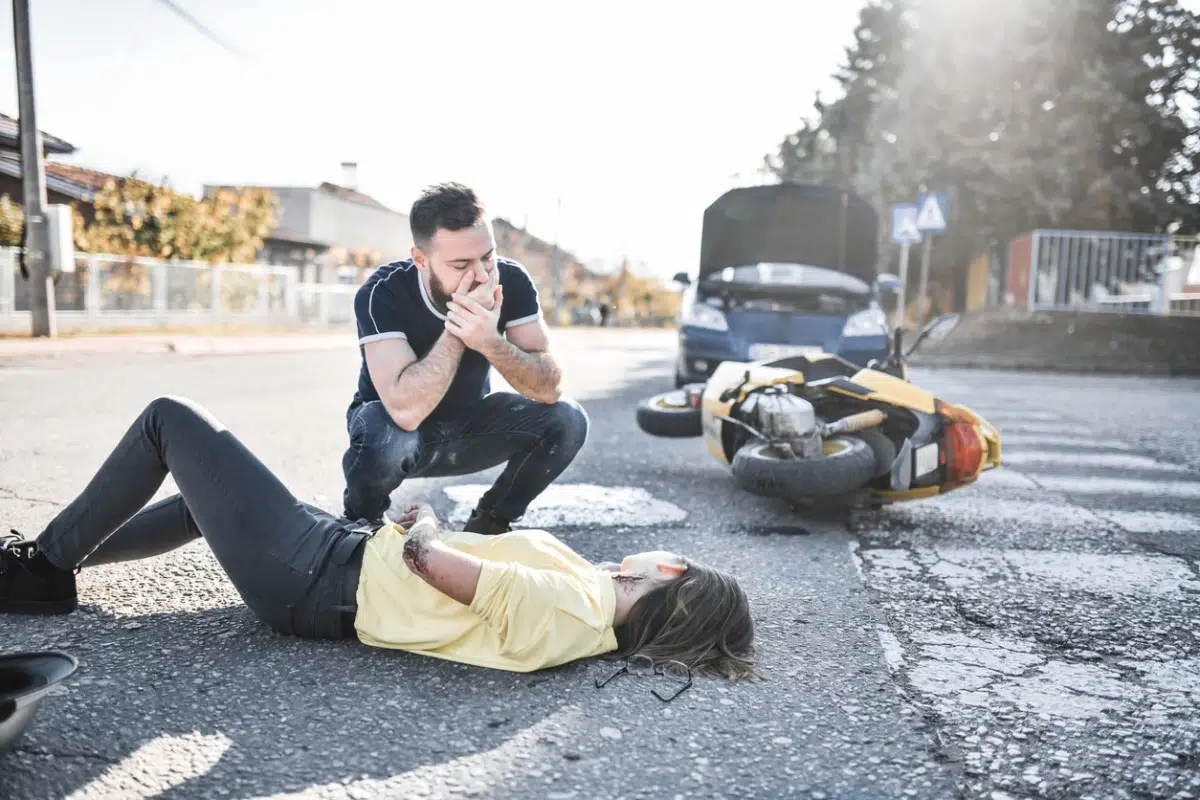
Riding a motorcycle offers an unparalleled sense of freedom and connection with the road. However, this exhilarating experience comes with inherent risks. Motorcycle accidents, unfortunately, can lead to severe injuries, primarily because motorcycles lack the encompassing protective structures found in passenger cars and other enclosed vehicles. This absence of a metal cage, airbags, and seatbelts means that in the event of a crash, a rider’s body is far more vulnerable to direct impact and trauma.
The repercussions of any personal injury can be life-altering, but the stakes are particularly high for motorcyclists. If you or a loved one has experienced such an unfortunate event, understanding your rights and options is crucial, and learning about motorcycle accidents can be a first step.
The Value of Injury Awareness and Legal Support
Understanding the common types of injuries that occur in motorcycle accidents and their underlying causes is vital. This knowledge not only promotes safer riding practices but also helps improve treatment outcomes for those who have been injured. Furthermore, for those navigating the aftermath of an accident, knowing what to expect in a motorcycle accident lawsuit can provide clarity during a challenging time.
Motorcycle accident injury lawyers play an indispensable role in this process, guiding injured motorcyclists through the complexities of the legal system to help them secure the maximum compensation they deserve for their common injuries in motorcycle accidents, pain, and suffering. It’s important to remember that injured riders often face not just physical wounds but also significant emotional stress, chronic pain, and the potential for long-term disability, underscoring the profound need for comprehensive support and dedicated rehabilitation services.
Types of Injuries in Motorcycle Crashes
The dynamics of a motorcycle crash mean that various parts of a rider’s body are exposed to potential harm. The resulting motorcycle crash injuries can range from relatively minor to life-threatening.
Lower Extremity Injuries
Perhaps the most frequently reported injuries in motorcycle accidents involve the lower extremities. A rider’s legs are highly exposed, and in a collision, they can easily be crushed, twisted, or impacted. Leg fractures (femur, tibia, fibula) are common. Beyond fractures, riders often sustain significant soft tissue injuries like road rash, lacerations, and severe bruising. Trauma to knees and ankles, including ligament tears and joint dislocations, is also prevalent. The frequency of these common motorcycle accident injuries underscores the vulnerability of a rider’s lower body.
Upper Extremity Injuries
The arms and shoulders are also at significant risk. Riders instinctively extend their arms to break a fall, leading to broken arms (humerus, radius, ulna), fractured clavicles, and shoulder injuries like dislocations or rotator cuff tears. These injuries in motorcycle accidents often require surgery and extensive physical therapy. “Biker’s arm,” a severe injury where the motorcycle lands on the rider’s arm, can cause crush injuries and extensive nerve damage (brachial plexus injuries), potentially leading to paralysis.
Head Injuries
Head injuries are among the most devastating consequences. Even with a helmet, impact forces can cause traumatic brain injuries (TBIs), ranging from mild concussions (headache, dizziness) to severe brain damage with cognitive deficits, memory loss, personality changes, and permanent impairment. Skull fractures are also a serious concern, risking underlying brain injury or infection. Head trauma from motorcycle accident events highlights the critical importance of helmet use and immediate medical attention. Open-face motorcycle helmet injuries can be particularly severe to the face and jaw, though any head injury is a major concern.
Spinal Injuries
The spine is highly vulnerable. Impact forces can cause vertebral fractures, herniated discs, or direct spinal cord damage. Spinal cord injuries can lead to catastrophic consequences like paraplegia or quadriplegia. Even less severe spinal injuries can result in chronic pain, limited mobility, and long-term disability. Neck injuries, such as whiplash or cervical fractures, are another serious injury sustained in motorcycle crashes, often requiring careful evaluation and prolonged treatment.
Internal Injuries
While external injuries are visible, internal injuries can be more insidious and life-threatening. Collision forces can cause internal bleeding, organ damage, or rupture, often requiring prompt surgery. Some injuries require surgery as a matter of course, especially in severe cases involving complex fractures, organ damage, or critical head trauma.
Rehabilitation
Recovery after a serious motorcycle accident is often long and arduous. Rehabilitation, particularly physical therapy, is crucial. Therapists help injured motorcyclists regain mobility, strength, balance, and function in a process that is physically and emotionally demanding.
Internal Injuries from Motorcycle Accidents
Blunt force trauma in motorcycle accidents can severely damage internal systems, even without immediate outward signs.
Abdominal Injuries
The abdomen houses vital organs, and injuries here are dangerous. Trauma from direct blows, compression, or surrounding bone fractures can cause severe internal organ injuries. The liver, spleen, and kidneys are prone to laceration or rupture, leading to internal bleeding. Lungs and heart can suffer contusions or collapse. Such blunt force trauma requires immediate medical attention to prevent life-threatening complications like organ failure.
Traumatic Brain Injuries (TBIs)
TBIs can cause secondary issues like swelling and bleeding within the skull, further damaging brain tissue. Long-term effects include permanent brain damage, cognitive impairment (memory, concentration, problem-solving), and emotional trauma (anxiety, depression, PTSD). Comprehensive rehabilitation is essential.
Accident Injuries and Prevention
While injury potential is serious, it’s not inevitable. Injury prevention is paramount, as collisions are a major cause of injuries in motorcycle accidents. Riders are at higher risk due to a lack of protection and vehicle instability, emphasizing the need for defensive riding.
Many common injuries in motorcycle accidents, like road rash and biker’s arm, can be prevented or minimized by wearing protective gear: helmets, gloves, armored jackets/pants, and sturdy footwear. Proper gear is a crucial barrier. In cases of severe burns, skin grafts may be needed.
Rider behavior is a massive factor. Avoiding reckless actions (speeding, aggressive weaving, riding under the influence) is fundamental. Maintaining situational awareness – scanning, checking mirrors, anticipating others – allows proactive responses to hazards.
Motorcycle safety courses and advanced training are invaluable, teaching hazard perception, emergency maneuvers, and bike control, significantly reducing accident and injury risk.
The Role of Protective Gear in Injury Prevention
The good news is that riders are not powerless. The single most effective measure a motorcyclist can take to mitigate the risk of severe injury, especially traumatic brain injury, is wearing protective gear. This includes armored jackets, durable pants, gloves, and boots, but most critically, a Department of Transportation (DOT)-approved helmet. The difference a helmet makes in a crash can be the difference between a minor incident and a catastrophic one for motorcycle accident victims.
Causes of Motorcycle Accidents
Understanding common causes is key to prevention. Accidents usually result from contributing factors.
Rider Behavior
Some accidents are due to rider actions: reckless driving, speeding (reduces reaction time, increases impact severity), or failure to yield. Responsible riding is the first defense against common motorcycle accident injuries.
Other Drivers’ Negligence
Many accidents occur because other drivers fail to see motorcyclists or misjudge their speed/distance. Common scenarios include cars turning left into an oncoming motorcycle or changing lanes into a rider’s path. This highlights the need for driver vigilance and rider defensive positioning.
Road Conditions
Potholes, uneven pavement, loose gravel, oil slicks, or debris can cause loss of traction. Riders must be aware and adjust accordingly. Poor road design or signage can also contribute.
Vehicle Defects or Malfunction
Less common, but mechanical failures (tire blowouts, brake failure) can cause loss of control. Regular maintenance and pre-ride inspections are crucial.
When accidents occur, injured motorcyclists may be entitled to compensation. Experienced motorcycle injury lawyers can investigate, determine liability, and assist victims.
Medical Implications of Motorcycle Accident Injuries
The physical toll often extends far beyond initial treatment, with significant long-term medical implications.
Injured riders frequently face chronic pain, permanent scarring, and long-term disability, underscoring the need for comprehensive medical care and rehabilitation. Many motorcycle crash injuries necessitate surgery, followed by lengthy physical therapy.
TBIs can have profound, lasting consequences: cognitive impairment, emotional trauma, and personality changes, requiring specialized rehabilitation. Spinal injuries can result in paralysis or chronic pain, demanding prompt medical attention and comprehensive rehabilitation.
Beyond physical wounds, victims often experience significant emotional stress (anxiety, depression), highlighting the need for psychological support.
Legal Considerations for Motorcycle Accident Victims
When a motorcycle accident causes injury, victims face physical, emotional, and financial challenges. Understanding legal rights is critical.
Victims may be entitled to compensation for medical expenses (current and future), lost wages, lost earning capacity, pain and suffering, emotional distress, and loss of enjoyment of life. Experienced motorcycle injury attorneys are invaluable in navigating this.
Negligence by other drivers, government entities (unsafe roads), or vehicle manufacturers can be grounds for liability. Identifying liable parties and taking prompt legal action are crucial.
Seeking legal advice from a qualified attorney as soon as possible is highly advisable. Early consultation protects rights and helps build a strong case. Many firms, including those known as the best motorcycle injury lawyer providers, offer free consultations.
Motorcycle injury attorneys provide comprehensive support: handling insurance communications, gathering evidence (police reports, witness statements, medical records, expert testimony), building a case, and negotiating settlements. If necessary, they are prepared for trial. Compensation can also cover future medical needs, rehabilitation, and lost earning potential.
Preventing Motorcycle Accidents and Injuries: A Rider’s Commitment
Preventing motorcycle accidents and common injuries in motorcycle accidents starts with a rider’s unwavering commitment to safe practices and risk management. While some factors are uncontrollable, many are not.
This means always wearing DOT-approved helmets and other protective gear (gloves, boots, armored clothing). This gear is the first line of defense. Adhering to traffic laws and maintaining constant alertness – actively scanning and anticipating – are fundamental to minimizing the risk of motorcycle crash injuries.
Experienced motorcycle injury attorneys at Delfino Green and Green can provide invaluable support post-accident, helping navigate legal and insurance processes to recover fair compensation.



